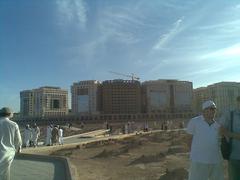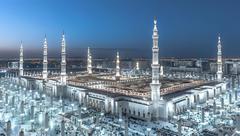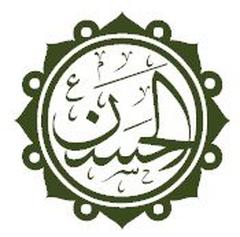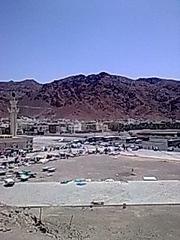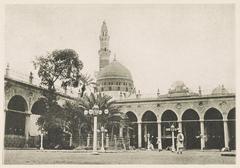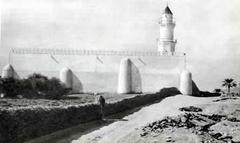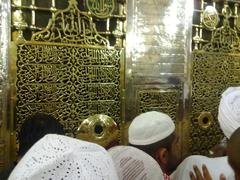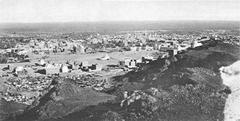Dar Al Madinah Museum Visitor Guide: History, Tickets, and Tips
Date: 18/07/2024
Introduction
The Dar Al Madinah Museum, located in the historic city of Medina, Saudi Arabia, offers visitors a unique opportunity to delve into the rich and diverse history of this region. Medina, known as the second holiest city in Islam, has a profound historical significance, particularly for its association with the Prophet Muhammad and the early days of Islam. The museum serves as a cultural and historical repository, providing invaluable insights into various periods, from pre-Islamic times to the Ottoman era. By visiting this museum, one can explore a wide array of artifacts and exhibits that narrate the story of Medina’s evolution, its role in the spread of Islam, and its cultural exchanges with other civilizations.
Table of Contents
- Introduction
- Exploring the Dar Al Madinah Museum
- Exhibit Highlights
- Visiting Dar Al Madinah Museum
- Conclusion
- FAQ
Exploring the Dar Al Madinah Museum
Historical Significance and Artifacts
The Islamic Era
The museum highlights the development of Medina as a center of Islamic civilization. Artifacts from the early Islamic period, including examples of early Islamic coinage, manuscripts, and pottery, provide tangible connections to the time of the Prophet Muhammad and the establishment of the first Muslim community in Medina.
Ottoman Influence
The museum’s collection extends to the later periods of Islamic rule, showcasing the artistic and cultural evolution of Medina under Ottoman rule. Visitors can explore displays of Ottoman-era artifacts such as weaponry, textiles, and decorative arts, reflecting the cultural exchange between the Ottoman Empire and the Arabian Peninsula.
Visitor Information
The Dar Al Madinah Museum is open from 9 AM to 5 PM, and tickets can be purchased at the entrance. For more information on visiting hours and ticket prices, please visit the official website. The museum’s location in Medina itself adds to its historical significance. Visitors can also explore nearby landmarks like the Prophet’s Mosque (Al-Masjid an-Nabawi), which houses the Prophet Muhammad’s tomb.
Travel Tips and Nearby Attractions
When planning a visit to the Dar Al Madinah Museum, consider the following tips:
- Best Time to Visit: Early mornings or late afternoons to avoid crowds.
- Nearby Attractions: Prophet’s Mosque, Quba Mosque, and the Qiblatain Mosque.
- Accessibility: The museum is wheelchair accessible, with ramps and elevators available.
Special Events and Guided Tours
The museum occasionally hosts special events and guided tours that offer deeper insights into its exhibits. Check the museum’s official website or contact the visitor center for the latest information on scheduled events and tours.
Exhibit Highlights
The Prophet’s Mosque (Al-Masjid an-Nabawi) Section
This section delves into the history and significance of the Prophet’s Mosque, the second holiest site in Islam. Exhibits may include:
- Architectural Models and Evolutions: Showcasing the mosque’s architectural transformations throughout history, from its humble beginnings to its current grandeur.
- Rare Artifacts: Displays of historical artifacts related to the mosque’s construction and expansion.
- Interactive Displays: Modern museums often utilize technology. This section might feature interactive maps, timelines, and multimedia presentations to engage visitors in the mosque’s history.
Medina Through the Ages
This section offers a chronological exploration of Medina, highlighting key periods:
- Pre-Islamic Medina: Artifacts and information about the city’s pre-Islamic history, potentially focusing on the Aws and Khazraj tribes and their significance.
- The Prophet’s Era: Exhibits focusing on the Prophet Muhammad’s arrival in Medina, the establishment of the first Muslim community, and pivotal events like the Battle of Badr and the Treaty of Hudaybiyyah.
- Early Islamic Caliphates: Medina’s role as the capital of the early Islamic caliphates, its political and religious importance during this period.
- Later Historical Periods: Exhibits tracing Medina’s development through various Islamic dynasties, including the Ottoman era and the subsequent unification of Saudi Arabia.
Islamic Arts and Culture
Given Medina’s central role in Islam, the museum dedicates a section to Islamic arts and culture:
- Calligraphy: Displays of exquisite Islamic calligraphy, showcasing different styles and their evolution, with a focus on Medina’s calligraphic traditions.
- Manuscripts and Texts: Exhibits of rare Islamic manuscripts and religious texts, potentially including copies of the Quran or historical documents from Medina’s scholarly heritage.
- Ceramics and Metalwork: Examples of Islamic ceramics and metalwork, highlighting the intricate designs and craftsmanship prevalent in different periods.
Urban Development of Medina
This section focuses on the city’s physical growth and urban planning:
- Maps and Models: Historical maps and scale models illustrating Medina’s urban development, showcasing its expansion and architectural changes over time.
- Infrastructure and City Life: Exhibits exploring the development of Medina’s infrastructure, including water systems, housing, and public spaces, offering insights into daily life in the city throughout history.
- Modern Medina: Displays focusing on the modern transformation of Medina, including its growth as a major city and the challenges of preserving its historical character alongside development.
Temporary Exhibitions
Museums often host temporary exhibitions to provide fresh perspectives and explore specific themes in greater depth. These could include:
- Focus on Specific Historical Events: Exhibitions dedicated to significant events in Medina’s history, such as the Prophet’s migration (Hijra) or the lives of prominent companions of the Prophet.
- Islamic Art and Artists: Showcasing the works of renowned Islamic artists or exploring specific art forms, like miniature painting or textile weaving, with connections to Medina.
- Cultural Exchange and Dialogue: Exhibitions promoting intercultural understanding and highlighting Medina’s role as a place of pilgrimage and cultural exchange.
Visiting Dar Al Madinah Museum
Visitor Information and Practical Tips
Planning Your Visit
- Location: Dar Al Madinah Museum is strategically located on King Abdul Aziz Road in Medina, Saudi Arabia, making it easily accessible to visitors.
- Operating Hours: The museum welcomes visitors every day of the week from 8:00 AM to 8:00 PM.
- Entrance Fee: As of July 18, 2024, information regarding the entrance fee is unavailable. It is recommended to check with the museum’s official website or contact their information desk for the most up-to-date details on ticketing and any potential fees.
- Photography: Photography is generally permitted within the museum. However, it’s always best to confirm with museum staff about any restrictions, especially regarding the use of flash photography, which might not be allowed in certain areas to protect the artifacts.
Making the Most of Your Visit
- Guided Tours: Enhance your experience by opting for a guided tour. Knowledgeable guides can provide in-depth explanations of the exhibits, historical context, and significance, enriching your understanding of the museum’s collection.
- Allocate Sufficient Time: To fully appreciate the museum’s extensive collection and immerse yourself in its historical narratives, it is advisable to allocate a minimum of two to three hours for your visit. This will allow ample time to explore the exhibits at a comfortable pace.
- Dress Code: As Medina is a city of great religious significance, it is essential to dress modestly when visiting Dar Al Madinah Museum. Both men and women are advised to wear loose-fitting clothing that covers their shoulders and knees. Women may also choose to wear a headscarf as a sign of respect.
- Accessibility: The museum strives to provide an inclusive experience for all visitors. It is designed to be accessible to individuals with disabilities, featuring ramps, elevators, and other amenities to ensure ease of movement and access to exhibits.
Getting There
By Car
If you are traveling by car, the museum is conveniently located on King Abdul Aziz Road, making it easily accessible from various parts of the city. Ample parking space is available for visitors.
By Taxi
Taxis are readily available throughout Medina and offer a convenient mode of transportation to reach the museum. You can easily hail a taxi from your location or book one through ride-hailing apps.
By Public Transportation
Medina has a reliable public transportation system, including buses, that can take you close to the museum. Inquire about the nearest bus stop to Dar Al Madinah Museum and plan your route accordingly.
Nearby Attractions
- The Prophet’s Mosque (Al-Masjid an-Nabawi): Located a short distance from Dar Al Madinah Museum, this mosque holds immense religious significance for Muslims worldwide. It is considered the second holiest site in Islam, after the Grand Mosque in Mecca.
- Al-Baqi’ Cemetery: Situated adjacent to the Prophet’s Mosque, this cemetery is the final resting place of many prominent figures from Islamic history, including members of the Prophet Muhammad’s family and companions.
- Uhud Mountain: Located approximately 5 kilometers from Medina, this mountain holds historical and religious importance as the site of the Battle of Uhud, a significant event in Islamic history.
Where to Stay
Medina offers a wide range of accommodation options to suit different budgets and preferences. From luxurious hotels to budget-friendly guesthouses, you can find suitable lodging near the museum or in other convenient locations within the city.
Where to Eat
Medina boasts a diverse culinary scene, offering a blend of traditional Saudi Arabian cuisine and international flavors. Numerous restaurants and eateries are located near the museum and throughout the city, where you can savor local delicacies or enjoy familiar dishes.
Conclusion
FAQ
What are the visiting hours for the Dar Al Madinah Museum? The museum is open every day from 8:00 AM to 8:00 PM.
How much are tickets to the Dar Al Madinah Museum? As of July 18, 2024, information regarding the entrance fee is unavailable. Please check the museum’s official website or contact their information desk for the most up-to-date details.
Is the museum accessible for visitors with disabilities? Yes, the museum is accessible and provides facilities to ensure a comfortable visit for all guests.
Are there guided tours available? Yes, guided tours may be available in various languages. Check with the museum for availability.
Can I take photos inside the museum? Photography is generally permitted, but be mindful of restrictions, especially near religious artifacts or texts. Always ask for permission if unsure.
